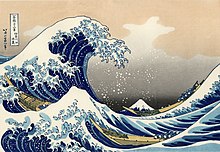Kanagawa Prefecture
Template:Infobox Prefecture Japan Kanagawa Prefecture (神奈川県, Kanagawa-ken) is a prefecture located in the southern Kantō region of Honshū, Japan. The capital is Yokohama. Kanagawa is part of the Greater Tokyo Area.
History
In medieval Japan, Kanagawa was part of the provinces of Sagami and Musashi.
Kamakura in central Sagami was the capital of Japan during the Kamakura period (1185-1333).
During the Edo period, the western part of Sagami Province was governed by the daimyo of Odawara Castle, while the eastern part was directly governed by the Tokugawa Shogunate in Edo (Tokyo).
Commodore Matthew Perry landed in Kanagawa in 1853 and 1854, and signed the Convention of Kanagawa to force open Japanese ports to the United States. Yokohama, the largest deep-water port in Tokyo Bay, was opened to foreign traders in 1859 after several more years of foreign pressure, and eventually developed into the largest trading port in Japan. Nearby Yokosuka, closer to the mouth of Tokyo Bay, developed as a naval port and now serves as headquarters for the U.S. 7th Fleet and the fleet operations of the Japan Maritime Self-Defense Force.
Yokohama, Kawasaki and other major cities were heavily damaged by the Great Kantō earthquake in 1923 and U.S. bombing in 1945.
Geography

Kanagawa is a relatively small prefecture wedged between Tokyo on the north, the foothills of Mount Fuji on the northwest, and the Pacific Ocean and Tokyo Bay on the south and east. The eastern side of the prefecture is relatively flat and heavily urbanized, including the large port cities of Yokohama and Kawasaki, but becomes more relaxed to the southeast, near the Miura Peninsula, where the ancient city of Kamakura draws tourists to its temples and shrines. The western part is more mountainous and includes resort areas like Odawara and Hakone.
The Tama River forms much of the boundary between Kanagawa and Tokyo. The Sagami River flows through the middle of the prefecture.
Cities
Nineteen cities are located in Kanagawa Prefecture:
|
|
Towns and villages
Transportation
Kanagawa's transport network is heavily intertwined with that of Tokyo (see: Transportation in Greater Tokyo). Most air travel to Kanagawa goes through Tokyo International Airport or Narita International Airport. The Tōkaidō Shinkansen provides high-speed rail service to Tokyo, Nagoya, Osaka and other major cities.
Education
The Kanagawa Prefectural Board of Education manages and oversees individual municipal school districts. The board of education also directly operates most of the public high schools in the prefecture.
Culture

- One of the most famous Ukiyo-e paintings is The Great Wave off Kanagawa by Hokusai.
- Kamakura city, known for its historical buildings, is a favored location used in many manga (comic) or anime (animation).
Sports
The sports teams listed below are based in Kanagawa.
Football (soccer)
- Kawasaki Frontale (Kawasaki)
- Yokohama F. Marinos (Yokohama, Yokosuka)
- Yokohama F.C. (Yokohama)
- Shonan Bellmare
Baseball
Volleyball
Tourism
The city of Kamakura is famous as the location of many Buddhist temples and Shinto shrines.
Yokohama Chinatown is the largest Chinatown in Japan (larger than Chinatowns in both Kobe and Nagasaki) and it is one of the largest in the world.
External links
- KANAGAWA NOW JAPAN Kanagawa Prefectural Tourist Association website (English)

